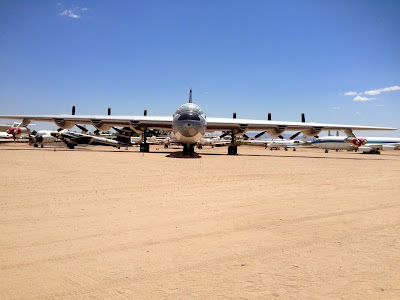Once upon a time, there were 384 of these aluminum monsters. Designed to allow us to strike targets in Europe from bases in the continental United States, for ten years--from 1949 through 1959--they stood ready to make America's enemies rue the day that they transgressed against us. But they never saw combat or delivered bombs in anger and eventually they were replaced with newer, smaller jet bombers.
But at 162 feet long and with a wingspan of 230 feet, the B-36 will always be remembered as the largest US bomber ever to take to the skies. Of the 384, four survive intact today in museums. (I've seen three of them.) Pima has one of them, and this aircraft in particular is one of the ones that I came here specifically to look at.
To watch the B-36 in action, check out this video:
Or review this older post and a clip from a movie that features both a B-36 AND James Stewart, who was a real-life Air Force bomber pilot and General in addition to being one of Hollywood's greatest actors.
Two Air Force greats: The B-36 Peacemaker and General James Stewart








Six turnin' and four burnin'!
ReplyDeleteI like how all six props are in the exact same position.
John in Philly
ReplyDeleteMy wife and I were visiting the Uvdar-Hazy Museum a while ago. They had a cut away of the Pratt and Whitney R-4360 engine. The engine looked like a swiss watch of precision machining and fine fitting moving parts.
But from the viewpoint of this engine room machinist mate, way to many moving parts. Steam turbines tend to run forever when the oil is kept clean, and having 6 of these big radials on one aircraft must have meant a ton of downtime for maintenance and repair.
A few years ago one of the flying B-17s was at Northeast Philadelphia Airport, and since I was coming home from work in uniform, I got tarmac access and was lucky enough to be standing about 20 feet away when they started all four engines. (My father was Army, then Army Air Corp in WWII, non flying part.) After all four had started safely I realized I was standing there with tears rolling down my face.
I can only imagine what getting all six started and then adding the jets into the mix must have sounded like.
John in Philly
Wonderful pics, if kinda bittersweet. I first saw that bird in 1970, where it graced the entrance to Great Southwest "International" - a side trip to our 4th grade class' field trip to the American Airlines training center just across TX-360. When GSW closed due to the opening of D/FW Int'l in '74, the B-36 was repeatedly vandalized until finally being moved to the other side (west) of Ft. Worth, to [then] Carswell AFB (now NAS-JRB).
ReplyDeleteWhat gets my goat is that the a$$clowns in FTW (a$$clownery is usually associated with Dallas, not FTW) - both city officials and L/M executives, squandered the opportunity to complete the restoration and display her in the city of her birth.
Good on Pima for doing the right thing! Gorgeous airplane!
P.S.: The first picture here shows 2827 coming off the line at the Convair plant. Someone may correct me here, but I'm pretty sure the view is to the South.
ReplyDeleteIn '05 or '06, as an Asst. Scoutmaster, we took our Troop on a tour of that plant (one ASM dad was a L/M engineer, another was a AF Reserve Falcon driver). I think that I'd be correct in asserting that the area just aft of the B-36's tail in the pic, and off the starboard wingtip, was where we saw UAE and IAF 'lawn darts' side by side, nearing final assembly.
Even more sadly, the restoration was complete enough that the aircraft could have been flown away and it was supposed to fly away, but at the last minute, after engines had been test run successfully, the bureaucrats put the nix on it and she was disassembled and trucked away.
ReplyDeleteI always liked what the Crew Chiefs said about them.....
ReplyDelete"two turning, two burning, two joking, and two smoking, with two engines not accounted for"
I heart those planes so much.
ReplyDeleteYou and me both. There were something.
DeleteThanks for the pictures
ReplyDeleteRan across a little more info about this particular aircraft in "This Day in Aviation" blog. http://www.thisdayinaviation.com/12-february-1959/
ReplyDelete